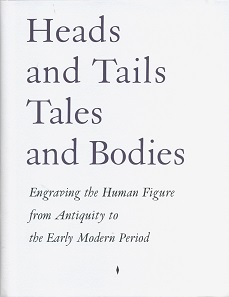by Ursula Kampmann
translated by Annika Backe
May 18, 2017 – Are you an esthete? Then you should definitely take a look at the exhibition catalog published by the Benaki Museum in Athens and the Pushkin State Museum in Moscow. It is dedicated to a topic that has fascinated artists since the dawn of time: the human body.
Vasiliki Penna (ed.), Heads and Tails – Tales and Bodies. Engraving the Human Figure from Antiquity to the Early Modern Period. MER. Paper Kunsthalle, Ghent 2016. 405 pages with black-and-white illustrations and 120 color plates, 27.7 x 22.2 cm, hardcover. ISBN: 978-94-9232-131-2. 80 euros.
This aesthetic aspect constitutes the leitmotif of the catalog “Heads and Tails – Tales and Bodies. Engraving the Human Figure from Antiquity to the Early Modern Period”. It is about the beauty of the human body and about the virtuosity with which artists have represented this body for centuries. The presented works of art mainly stem from Greek and Roman antiquity as well as the early modern period, but Byzantine art is not omitted, either.
In the tradition of an excellent coffee table book, the weighty catalog offers the chance to soak oneself into the absolute beauty of good art. Whether a minute or an hour, it is not a question of how much time you invest. Already the introductory section of plates – all on black ground, all designed according to aesthetic criteria – casts a spell on the viewer that is generated by the perfect reproduction of the human body.
A catalog of exhibition projects follows. It entails brief introductions and short explanations, which help to understand the objects without distorting their beauty by academic details. Coins and statues are treated equally. Each object is introduced on one page and in a text that spans about half a page.
The catalog starts with representations that illustrate the connection between the divine and the human body. We see the perfect man as the epitome of divinity, from Greek antiquity to the icon of Byzantine times.
The following chapter on the human factor presents marvelous portraits, on busts and coins. They are shown not in a chronological sequence but in such a meaningful arrangement that the similarity between the portrait of Alexander, issued by the Macedonian koinon under the reign of Gordian III, with the Hellenistic ruler Demetrius Poliorcetes suddenly becomes apparent. The temporal spectrum ranges from a portrait of satrap Gamerses to the early and high Middle Ages, the Renaissance and Napoleon.
Under the heading of personification and metamorphosis, the intermediate stages of man and beast are addressed, the river god and the nymph, the city goddess and the personification. The focus is on the Roman period, although there are of course examples from other eras as well.
Human Figures and Artistic Challenges is the heading of the fourth chapter. Here, the reader discovers a wealth of interesting representations. Strictly speaking, they are not held together by any common element, but there are always groups. Wrestlers and warriors, dancers and portraits, hands, the triskele, and much more has been compiled, coming from different times and places.
How coin imagery traveled, changed, adapted to the culture that minted a coin, makes the theme of the last chapter.
Next are some articles that provide a kind of chronological approach. The human body and how man understood it is traced through time, from prehistory to classicism.
The luxury volume ends as it has begun, with a block of magnificent plates that comments on the aesthetic concept of the exhibition. Unusual perspectives and artistic photos sum up what the book can be to the reader: a haven of beauty, a recreation from everyday life, a vacation from the appalling present, to become engrossed in for a few minutes or half an eternity before facing the problems of everyday life again.
You can order the book from the publisher.





